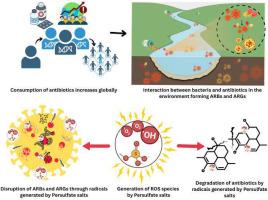当前位置:
X-MOL 学术
›
Water Res.
›
论文详情
Our official English website, www.x-mol.net, welcomes your
feedback! (Note: you will need to create a separate account there.)
Persulfate salts to Combat Bacterial Resistance in the Environment through Antibiotic Degradation and Biofilm Disruption
Water Research ( IF 11.4 ) Pub Date : 2025-06-01 , DOI: 10.1016/j.watres.2025.123941
Feeba Nissi Anandraj, Tapan Kumar Panda, Sadhasivam Thangarasu, Gowthami Palanisamy, Krishna Rao Eswar Neerugatti
Water Research ( IF 11.4 ) Pub Date : 2025-06-01 , DOI: 10.1016/j.watres.2025.123941
Feeba Nissi Anandraj, Tapan Kumar Panda, Sadhasivam Thangarasu, Gowthami Palanisamy, Krishna Rao Eswar Neerugatti

|
Antibiotic-resistant bacteria (ARB) and antibiotic-resistant genes (ARGs) have become a critical topic among researchers because of the excessive use of antibiotics in human and animal health care. Globally, it poses a serious threat to human health and the environment. Antibiotics are often poorly metabolized, with 30-90 % excreted into the environment, contaminating aquatic and ground ecosystems, and fostering resistance. Advanced oxidation processes (AOPs), particularly sulfate radical-based AOPs (SR-AOPs), offer promising solutions for degrading antibiotics and resistant biofilms. Persulfate (PS) and Peroxymonosulfate (PMS) are key oxidants in these processes, generating sulfate and hydroxyl radicals when activated by heat, UV light, or transition metals. PS, with a redox potential of E°=2.01 V, is an affordable and effective oxidant but requires activation to break down contaminants. Because of its ability to function independently without activation, PMS is stable across a broad pH range and produces both sulfate and hydroxyl radicals, making it a versatile agent for environmental treatment. This review broadly describes the degradation mechanisms of different classes of antibiotics and biofilms. Despite these promising developments, SR-AOPs still face challenges in managing complex wastewater systems, which often contain multiple pollutants. Moreover, gaps remain in our understanding of the toxicity of reaction intermediates and in optimizing the large-scale application of these processes. Future research should focus on the in-situ generation of sulfate radicals, combining different activation methods to enhance degradation efficiency, and developing sustainable and cost-effective approaches for large-scale wastewater treatment.
中文翻译:

过硫酸盐通过抗生素降解和生物膜破坏来对抗环境中的细菌耐药性
由于抗生素在人类和动物保健中过度使用,抗生素耐药菌 (ARB) 和抗生素耐药基因 (ARG) 已成为研究人员的关键话题。在全球范围内,它对人类健康和环境构成严重威胁。抗生素通常代谢不良,30-90% 排泄到环境中,污染水生和地面生态系统,并促进耐药性。高级氧化过程 (AOP),特别是基于硫酸根自由基的 AOP (SR-AOP),为降解抗生素和耐药性生物膜提供了有前途的解决方案。过硫酸盐 (PS) 和过氧一硫酸盐 (PMS) 是这些过程中的关键氧化剂,当被热、紫外线或过渡金属激活时,会产生硫酸盐和羟基自由基。PS 的氧化还原电位为 E°=2.01 V,是一种经济实惠且有效的氧化剂,但需要活化才能分解污染物。由于 PMS 能够在不激活的情况下独立发挥作用,因此在较宽的 pH 值范围内保持稳定,并产生硫酸根和羟基自由基,使其成为环境处理的多功能剂。本综述广泛描述了不同类别的抗生素和生物膜的降解机制。尽管取得了这些有希望的进展,但 SR-AOP 在管理复杂的废水系统(通常包含多种污染物)方面仍然面临挑战。此外,我们在了解反应中间体的毒性和优化这些过程的大规模应用方面仍然存在差距。未来的研究应侧重于硫酸根自由基的原位生成,结合不同的活化方法以提高降解效率,并为大规模废水处理开发可持续且具有成本效益的方法。
更新日期:2025-06-02
中文翻译:

过硫酸盐通过抗生素降解和生物膜破坏来对抗环境中的细菌耐药性
由于抗生素在人类和动物保健中过度使用,抗生素耐药菌 (ARB) 和抗生素耐药基因 (ARG) 已成为研究人员的关键话题。在全球范围内,它对人类健康和环境构成严重威胁。抗生素通常代谢不良,30-90% 排泄到环境中,污染水生和地面生态系统,并促进耐药性。高级氧化过程 (AOP),特别是基于硫酸根自由基的 AOP (SR-AOP),为降解抗生素和耐药性生物膜提供了有前途的解决方案。过硫酸盐 (PS) 和过氧一硫酸盐 (PMS) 是这些过程中的关键氧化剂,当被热、紫外线或过渡金属激活时,会产生硫酸盐和羟基自由基。PS 的氧化还原电位为 E°=2.01 V,是一种经济实惠且有效的氧化剂,但需要活化才能分解污染物。由于 PMS 能够在不激活的情况下独立发挥作用,因此在较宽的 pH 值范围内保持稳定,并产生硫酸根和羟基自由基,使其成为环境处理的多功能剂。本综述广泛描述了不同类别的抗生素和生物膜的降解机制。尽管取得了这些有希望的进展,但 SR-AOP 在管理复杂的废水系统(通常包含多种污染物)方面仍然面临挑战。此外,我们在了解反应中间体的毒性和优化这些过程的大规模应用方面仍然存在差距。未来的研究应侧重于硫酸根自由基的原位生成,结合不同的活化方法以提高降解效率,并为大规模废水处理开发可持续且具有成本效益的方法。


















































 京公网安备 11010802027423号
京公网安备 11010802027423号